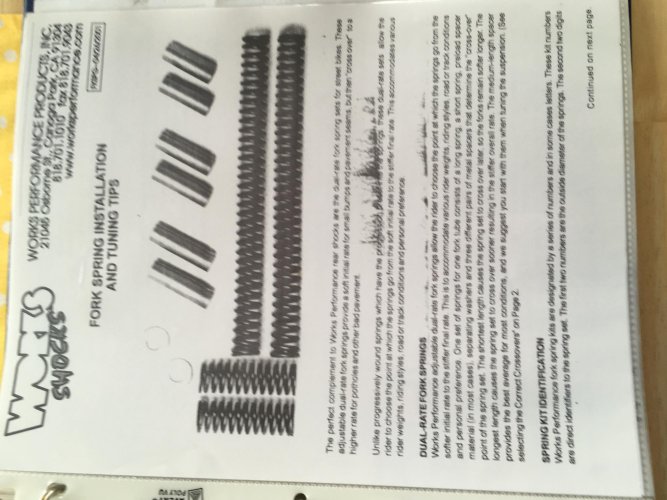evillerich
New member
Hello,
I'm in the process of "refreshing" my 1987 K75S that I purchased last summer. Currently I'm focusing on the front end. I have the Clymer manual as a resource. This is my first motorbrick.
I picked up a set of slightly bent fork tubes from a gent who had an unfortunate get-off (also a 1987 K75S). These fork tubes are rumored to have Progressive springs. I'm looking to install those springs on my bike.
I'm taking the damaged fork tubes apart one at a time so I can learn as I go. I got the top cap off the first tube and found underneath it two plastic tubes (I think the "distance tubes" per Clymer). I then found a relatively short spring (maybe 4 inches) that is not progressively wound. Under that is a much longer spring that is progressively wound. I'm assuming this is the right order of things and have four questions, the last last of which is the big one:
1) Is what I'm seeing in the correct order from top to bottom - top cap, distance tube 1, distance tube 2, short not-progressive spring, long progressive spring?
2) Is the short spring and long spring part of the Progressive spring kit? Or just the longer one? If I disassembly my bike, for which I expect to find the stock setup, will I find two springs, neither of which are progressively wound that would simply be replaced by the springs from my donor forks?
3) Is there a difference between the left and right fork? On my donor forks, I do not know which side is which. I don't have the lower tube for reference. Just the top (shiny) tube.
4) Is it wise to attempt to replace my springs without removing my forks? I was thinking of the following procedure:
a) Drain oil from the bottom
b) Compress top cap (I'm worried this will be difficult as I'll be pushing against both the top and bottom as I attempt to compress the fork cap)
c) Fish out the various distance tubes and springs, letting each fork compress slowly
d) Reassembling reverse of removal
e) Fill with oil
f) Profit
Or should I just punt on #4 and remove the fork tubes. I'm not sure which is the lazier, I mean better, approach.
I'm a n00b on this bike but have been digging into all sorts of basic stuff to get it back in shape. The forks are totally foreign to me in my mechanical experience.
Thanks much!
Eville Rich
'87 K75S
'16 Super Tenere
'15 WR250R
I'm in the process of "refreshing" my 1987 K75S that I purchased last summer. Currently I'm focusing on the front end. I have the Clymer manual as a resource. This is my first motorbrick.
I picked up a set of slightly bent fork tubes from a gent who had an unfortunate get-off (also a 1987 K75S). These fork tubes are rumored to have Progressive springs. I'm looking to install those springs on my bike.
I'm taking the damaged fork tubes apart one at a time so I can learn as I go. I got the top cap off the first tube and found underneath it two plastic tubes (I think the "distance tubes" per Clymer). I then found a relatively short spring (maybe 4 inches) that is not progressively wound. Under that is a much longer spring that is progressively wound. I'm assuming this is the right order of things and have four questions, the last last of which is the big one:
1) Is what I'm seeing in the correct order from top to bottom - top cap, distance tube 1, distance tube 2, short not-progressive spring, long progressive spring?
2) Is the short spring and long spring part of the Progressive spring kit? Or just the longer one? If I disassembly my bike, for which I expect to find the stock setup, will I find two springs, neither of which are progressively wound that would simply be replaced by the springs from my donor forks?
3) Is there a difference between the left and right fork? On my donor forks, I do not know which side is which. I don't have the lower tube for reference. Just the top (shiny) tube.
4) Is it wise to attempt to replace my springs without removing my forks? I was thinking of the following procedure:
a) Drain oil from the bottom
b) Compress top cap (I'm worried this will be difficult as I'll be pushing against both the top and bottom as I attempt to compress the fork cap)
c) Fish out the various distance tubes and springs, letting each fork compress slowly
d) Reassembling reverse of removal
e) Fill with oil
f) Profit
Or should I just punt on #4 and remove the fork tubes. I'm not sure which is the lazier, I mean better, approach.
I'm a n00b on this bike but have been digging into all sorts of basic stuff to get it back in shape. The forks are totally foreign to me in my mechanical experience.
Thanks much!
Eville Rich
'87 K75S
'16 Super Tenere
'15 WR250R




 . I just read a lab test of about 30 different weights and brands and it's so. The only thing that makes sense is that a higher weight oil of any brand is thicker than a lower weight of the same brand.
. I just read a lab test of about 30 different weights and brands and it's so. The only thing that makes sense is that a higher weight oil of any brand is thicker than a lower weight of the same brand.